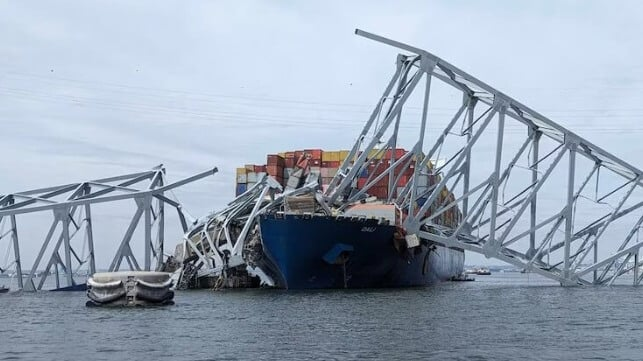As the National Transportation Safety Board hunts for the cause of the boxship Dali’s disastrous allision, investigators are looking closely at the electrical system, chair Jennifer Homendy told a Senate panel on Wednesday.

In the early hours of March 26, the Dali lost all power and propulsion as she approached Baltimore’s Francis Scott Key Bridge. Unable to stop, the Dali drifted into one of the bridge’s piers, collapsing the entirety of the through-truss center section of the bridge. Six workers who were patching potholes on the center span died in the collapse, and one worker was injured. Removing the wreckage is expected to take months, and rebuilding will take years.
NTSB investigators are looking at every possible factor in the incident. Tests of Dali’s fuel have reportedly come back clean and on-spec, and officials have said that there are no signs of intentional wrongdoing; equipment faults are also on the list, and the OEM has sent experts to help NTSB comb through the Dali’s systems for clues. Early signs point to the electrical system, Homendy said, and manufacturers’ representatives have flown out to examine the vessel’s circuit breakers in particular.
Some members of the shipping industry believed that Dali was over-operated and under-maintained due to reduced utilization during the 2020 refit. There is also a possibility that the Dali’s use of poor-quality, low-sulphur fuel in Latin America has led to equipment damage, since it is difficult to control the quality of the ship’s fuel during voyages in Asia and the Americas, such as through the Panama Canal.
However, according to the results of the latest investigation, the ship’s fuel test results were normal and compliant, and there were no indications of intentional misconduct. Equipments troubleshooting is also under investigation, and the equipment manufacturers have sent experts to help the National Transportation Safety Board sort through the Dali’s system problems for clues.
According to Jennifer Homendy, early indications show that the problem is with the Dali’s electrical system, and the system’s manufacturer has gone to participate in the investigation, specifically checking the ship’s circuit breakers.
“That is where our focus is right now in this investigation,” Homendy told the Commerce, Science and Transportation Committee. “Of course, that’s preliminary. It could take different roads, different paths as we continue this investigation. It’s very early.”
Homendy has also said that investigators are looking at the bridge’s design and its protection from ship traffic. The Key Bridge opened in the late 1970s, when most merchant ships were far smaller, and civil engineering experts have questioned whether the bridge was adequately updated to keep up with modern risks.
“Are these bridges protected for the types of traffic that is going through now? . . . If I was a state and the Department of Transportation, that’s what I’d be looking at now,” said Homendy.
Data show that the “Dali” was built by HD Hyundai Heavy Industries (formerly Hyundai Heavy Industries) Ulsan Shipyard in 2015 and delivered to the shipowner, classed by Nippon Kaiji Kyokai (ClassNK). The container ship is 300 meters long and 48 meters wide with a capacity of 9,962 TEU, including 1,400 reefer slots. Notably, it is equipped with B&W 9S90ME-C9 main engines and HIMSEN 9H32/40HD auxiliary engines for power generation, also manufactured by HD HHI.
As HD Hyundai Marine Solutions has warranty obligations for Dali and is based on HD Hyundai’s engine technology, the company’s IPO plans may also be affected by this incident. However, some analysts believe that the HIMSEN 9H32/40 engines equipped on Darley have been installed on many container ships over the years, so it is unlikely that there is a design flaw in the engines.
Marcos Alvarez, managing director of global insurance ratings at credit rating agency Morningstar DBRS, said that depending on the cycle of marine shipping blockages caused by the accident and the nature of the business interruption coverage at the Port of Baltimore, insurers could be required to pay claims in the range of $2 billion to $4 billion. Additionally, removing debris from the collapsed bridge and building a new one would cost another $2 billion.


